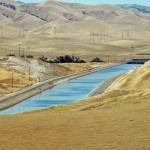
Only a few short months ago, Allen Short and the Modesto Bee were pushing the sale of “surplus water” to San Francisco. Short was then General Manager of the Modesto Irrigation District (MID). He departed under a cloud, partly because the sale proposal proved immensely unpopular with local farmers and partly because of an internal investigation yet to be revealed to the public.
Despite Short’s demise, the Bee is still promoting his water agenda, perhaps because he remains on the MID payroll through his role at the San Joaquin Tributaries Authority (SJTA). Now that Short is working for the SJTA, he’s reinvented himself as the local farmer’s friend by opposing increased flows along the Tuolumne River. He’s been aided and abetted by the Bee, which seems determined to push his agenda to the bitter end.
To realize how committed to Short’s success the Bee really is, just contrast the position of its parent organization in Sacramento. On May 12, the Sacramento Bee published an editorial titled, “If BDCP were science-based, Delta flows would be a priority.”
The “BDCP” is the Bay Delta Conservation Plan. It’s been put forward by representatives of political powers south of the Delta, including the Metropolitan Water District of Southern California and the Westlands Water District. These are the leading forces behind Governor Jerry Brown’s Delta tunnels proposal. They’re also the reason for local concerns that flows intended for Delta restoration will be diverted south.
What the Bee hasn’t told its readers is that science overwhelmingly supports the need for increased flows. In fact, most likely following Allen Short’s lead, the Bee has argued that the proposal for increased flows goes too far:
The water board needs to adopt a more comprehensive approach and give more consideration to other factors affecting salmon population—predator fish (striped bass), lack of floodplains and other habitat, poor water quality, pumping, overfishing and ocean conditions.
The Bee’s laundry list of factors omits mention that increased flows not only address most of these problems, they are a necessary condition for recovery—not just for salmon, but for the entire Delta ecosystem.
Scientists have already addressed the myriad factors involved in decline of our fisheries and the Delta itself. The Sacramento Bee editorial accurately summarized the findings of science as follows:
Asked which stressors were most important in the degradation of the Delta ecosystem, 78 percent of scientists included flows in their top-two list, with 77 percent including habitat restoration.
The editorial continued:
…it is not Delta interests who are driving the train in the Delta. Quite the opposite. For six years, the water exporters have been the driving force behind the hugely expensive Bay Delta Conservation Plan, arguing that little or no extra water is needed for the Delta, even though freshwater flows have been reduced by half in recent years.
Valley citizens should realize that both Allen Short and the Modesto Bee are helping push an agenda favored by water exporters far south of our region. They should know that science is against Short’s and the Bee’s positions.
In marked contrast to its Modesto counterpart, the Sacramento Bee has based its position on the findings of scientists. In fact, it has argued that Jerry Brown’s proposal to build tunnels or other means of water conveyance before studying the water requirements of the Delta ecosystem “won’t pass legal muster.”
Allen Short and the Modesto Bee have taken a stand virtually identical to that of the political powers behind the Bay Delta Conservation Plan. Valley citizens need to know just how little chance their arguments have of succeeding. For confirmation, all they need do is scan the arguments of the Bee’s Sacramento parent.
